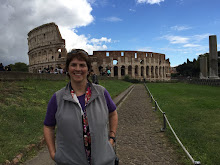Sam Kean has some pretty good stories in the chapters to demonstrate the wild and wacky ways of nature and the complexity of DNA. If you're like me, and use the terms DNA and genes interchangeably, well...they are two different things. Genes are in DNA, and they are inherited from our parents. They determine traits we will receive from each parent. DNA is basically the giant cloud that holds all the genes. I could go into chromosomes, but I won't. Some parts of the DNA/gene science explanations went right over my head. What I loved were the stories Kean told.
Like the story of Paganini, often lauded as the best violin player ever known to man. He was pretty brilliant, and could play like no other. The reason for this was because of his crazy uber-flexible fingers and hands. He could play parts of the violin that no one else could. What no one realized was that he suffered from what is now known at Ehlers-Danlos Syndrome. People who have this syndrome can't make collagen, which makes their joints hyper-flexible. It also causes skin to thin and become very sensitive; bowel issues, vision impairment, and a host of other problems. People thought Paganini sold his soul to the devil in order to play so magnificently.
Did you know that the liver of a polar bear is toxic to humans? You may think, "Why would I ever have to worry about this?" and that's a fair question. But, early explorers of the Arctic Circle found themselves chosing between starvation or feasting on polar bears (who were also feasting on the men). After eating the liver of a polar bear, an expedition became violently ill; vomiting, dizziness, sensitivity to sunlight, and the most spectacular of all, sloughing off of skin. It seems the polar bear's liver stores an enormous amount of vitamin A, and through thousands of years of evolution, the polar bear has adapted to eating seals (who produce a lot of vitamin A in order to continually replenish skin cells to stay warm) without becoming ill themselves. After all, seals were the only food source polar bears had, way up North. It was either adapt or be starved out of existence. Pretty cool!
There are loads more stories in The Violinist's Thumb on odd genes and why they do what they do. I had a hard time at first getting through the scientific bits, but soon became deeply interested in reading all of the stories about people and animals who are living proof that we continue to change, yet stay the same, on a cellular level.
This is a great book for any high schooler or collegiate who is showing interest in science, biology, or even archaeology and forensics. There are so many new fields of study popping up because of the interest in genetics that most anyone will find this book fascinating.
Rating: 7/10 for a scientific book that explains science for the masses, along with pretty cool stories that show our genetic quirks in action.
Available in paperback, e-book, and audio.



I have been meaning to find and read a book about genetics. This might be a good one for me to start with.
ReplyDeleteThere are definite sections at the beginning that are heavy on the science side, but the stories Kean peppers through the book make it fun to read!
DeleteOk I love weird science stuff like this. Excuse me while I go buy this and embrace my not so well hidden nerdiness
ReplyDeleteI had lots of wow! moments reading this book. Sure to give you good conversation bits at a party :)
DeleteThis is really a good book if you want to know about genetics and its behaviors. The scientific book further explains the masses, along with pretty cool stories that show our genetic quirks in action.
ReplyDelete